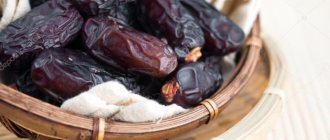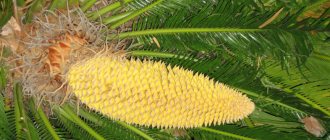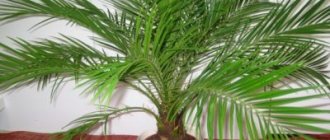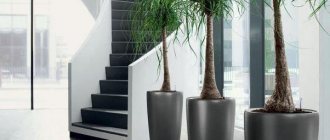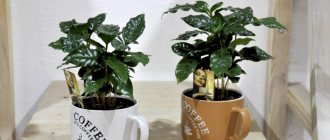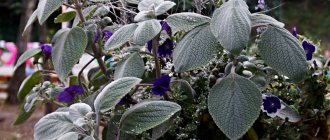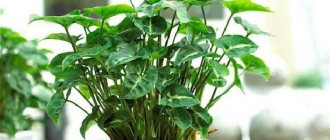Washingtonia filamentosa is a fan palm that will brighten up your living room or porch. The main condition is to provide a bright and warm place. It is best to purchase a young plant - it is cheaper and easier to adapt to new conditions. The main thing to remember is that over time the plant will reach a significant size and will need to be given a lot of space.
Washingtonia filamentosa is a very attractive plant. A rosette of large fronds, split into numerous segments, appear from the brown stem of a plant of this species. Their shape resembles a fan.
The uncoupled fronds of Washingtonia filamentosa are leathery, gray-green, and at the top they are divided into narrow filaments. Translated from Latin, it means “filigree” and describes the amazing pattern of thin threads hanging from the leaves of Washingtonia. If you carefully examine the leaf of this palm tree, you will see a plexus of long brown fibers at its edges.
In the wild, Washingtonia filamentosa is found in the desert regions of California and Arizona. There this palm reaches 9 meters in height, and sometimes even more. At home, Washingtonia rarely grows more than 2.4 meters in height.
With age, Washingtonia filamentosa becomes less sensitive to cold, but young palm trees need to be reliably protected from the cold. They are grown indoors and if taken outside provide them with additional protection. In winter, the air in the room with a palm tree should not be too humid.
Washingtonia filamentosa with several stems is sometimes found in flower shops or specialty centers. In fact, these are several plants planted in one flower pot to achieve greater effect. Unfortunately, palm trees grown this way do not live as long as plants grown in individual containers.
Washingtonia filamentous lives 80-90 years. This attractive fan palm was named after George Washington, the first President of the United States.
Make sure that Washingtonia filamentosa retains its attractive appearance. To do this, regularly trim withered and dried fronds at a height of 13 mm from the base. At least twice a year, clean the leaves of the plant, shake off dust from them and wipe them with a damp cloth.
The cost of this palm tree always depends on the size.
Washingtonia is an unpretentious fan palm, provided that it is grown in a warm and bright place. Trim dead palm stems and leaves regularly.
Botanical description
Washingtonia (lat. Washingtonia) is a palm tree named after George Washington (the first President of the United States). There are only two species of these palms - Washingtonia filamentosa and Washingtonia stouta, and the genus itself is part of the Arekova family. The Washingtonia palm is a tree that grows up to 25 m in height and almost 1 m in diameter. But this is in its natural habitat. Fan-shaped leaves grow at the top of the trunk. Petiole up to 1.5 m long, with spines directed towards the trunk. Washingtonia rarely blooms indoors. In the USA and Mexico, baskets are woven from the fibers of the leaves, and flour is made from the fruits. In Europe, this palm is cultivated on the southern coast of the Mediterranean. At home, Washingtonia needs space and coolness. When the plant reaches a significant size, it is better to take it outside, if, of course, weather conditions allow this.
Flower design
This palm tree does not need to be supplemented with other plants; the only condition is a durable and beautiful flowerpot. Which will hold the palm tree and prevent it from falling out of the pot. Almost always, Washingtonia filamentosa is used as a single plant. She is given a central place in the room. Washingtonia filamentosa is an ideal plant for decorating a summer terrace. In our climate, this attractive plant cannot winter outside. But Washingtonia robusta tolerates low temperatures a little better, in addition, it can also be taken outside in the summer. The leaves of this palm resemble the leaves of Washingtonia filamentosa, but differ in the spines that run along the entire length of the leaf. Good luck to you.
Briefly about cultivation
- Flowering: The palm tree is grown as an ornamental foliage plant.
- Lighting: bright diffused light for 16 hours a day. In winter, additional artificial lighting is required.
- Temperature: in spring and summer – 20-24 ºC, no more, in winter – about 10 ºC.
- Watering: in spring and summer - after the top layer of the substrate has dried, in winter watering is symbolic.
- Humidity: high. During the growing season, it is recommended to spray the leaves twice a day and wash them with a damp sponge weekly. It is advisable to place containers of water around the plant. In winter, Washingtonia is not sprayed.
- Feeding: from spring to autumn 2 times a month with fertilizers with an emphasis on iron. At other times, fertilizing is not necessary.
- Dormant period: from late autumn to early spring.
- Replanting: in the spring and only if necessary: up to 7 years - once every 2 years, up to 15 years - once every three years, and after - every 4-5 years.
- Substrate: four parts turf soil, two leaves, two parts humus or peat and one part sand.
- Reproduction: seed.
- Pests: scale insects, whiteflies, spider mites and mealybugs.
- Diseases: the roots can rot from improper watering or lack of drainage in the pot, and the tips of the leaves can dry out from low air humidity.
Read more about growing Washingtonia below.
Where to put
— Lighting for this palm tree should be sufficient in the summer. The place should be bright, but protect the palm tree from direct sun. If the plant does not have enough light, its leaves will begin to turn yellow.
— The temperature in the summer for this palm tree should be comfortable. In summer, Washingtonia filamentosa needs warmth. This fan palm feels best at a temperature of 20-24 degrees. In winter, the minimum temperature should be 10 degrees, and the optimal temperature should be 13 degrees.
— Humidity must be maintained; to do this, regularly spray its leaves with water. You can also use some methods to increase the humidity. Place the pot on a tray filled with water containing pebbles. You can also use humidifiers. Or in the summer we regularly spray palm leaves.
You can read more about proper care of palm trees here.
Caring for Washingtonia at home
Lighting
The main misconception is that the Washingtonia palm tree loves the sun. When growing Washingtonia, it does not need direct rays of the sun; it needs bright but diffused light for at least 16 hours a day. It is advisable to grow Washingtonia on western or eastern windowsills. In winter or simply when daylight hours are short, additional lighting (fluorescent) is needed for normal growth. In summer, it is advisable to take Washingtonia outside to a bright but shaded place and cover it from precipitation. The room needs to be ventilated, but do not place the tree in a draft. Washingtonias need a lot of light throughout the year.
Temperature
In summer and spring, temperatures should fluctuate around 20-24 °C. If the temperature tends to 30 °C, then the plant needs to be moved to a cooler room, allowed to cool, then watered and sprinkled. In winter, the temperature should be around 10 °C. Do not be afraid, in its homeland the Washingtonia palm tree tolerates frosts down to -7 °C.
Watering Washingtonia
The Washingtonia plant at home is afraid of both waterlogging and lack of moisture, so this palm tree needs to be watered immediately after the top layer of soil has dried out - this is in spring and summer. Since the temperature drops in autumn, the frequency and abundance of watering is reduced. In winter, the main task is to prevent the earthen coma from drying out completely, i.e. water two to three days after the substrate has dried from above. Before watering, the water is allowed to settle (for a day), and watered only with warm water.
- Clerodendrum at home
Spraying
For the full development of Washingtonia, high air humidity is necessary, so in addition to daily spraying (preferably twice a day), it makes sense to place a container of water next to the pot. It is a good idea to occasionally wipe the leaves with a damp cloth.
Top dressing
Washingtonias at home need fertilizer for good growth. Best of all - with an emphasis on hardware. Feed in spring and autumn 2 times a month at equal intervals. The rest of the time, as well as immediately after transplantation or during illness, Washingtonia is not fertilized.
Trimming
It is advisable to trim Washingtonia leaves before they completely dry out - this slightly slows down the natural drying of the next leaves. If the leaves are not cut off when they are dry, then the dry leaves don’t need to be cut off anymore - they will hang beautifully around the trunk.
Washingtonia transplant
Washingtonia is transplanted only if it is really necessary, since after transplantation the palm tree needs time to “come to its senses” and growth slows down a little. Up to 7 years old, Washingtonia is replanted once every 2 years, from 8 to 15 years old - once every three years, and from 15 years old - every four years (possibly after 5 years). Transshipment or transplantation should be carried out before summer, preferably in early spring. Since the palm tree is not a small tree, they are grown in wooden tubs. The substrate is made up of either turf, leaf, humus soil and sand (4: 2: 2: 1), or in the same proportions, but instead of humus, add peat. It is advisable to feed adult specimens with organic fertilizers during transplantation - about 5 kg. As the roots become exposed on the surface, you need to add fresh substrate.
Growing from seeds
The Washingtonia palm tree reproduces by seeds in the spring – March-April. Anyone who wants to achieve success with the highest probability will use only fresh seeds. The older the seeds, the lower the chance of germination and the longer the time. Before planting, the seeds need to be filed (lightly) and soaked in water for 24 hours. The seeds are deepened 1 cm into a substrate made of equal parts of moss, sand and sawdust, with the addition of crushed charcoal. The sawdust must be steamed before preparing the substrate. After planting, water the soil, cover the container with glass and place it in a warm place, maintaining the temperature at 28-30 °C. If the seeds are fresh and the care is correct, the seedlings will appear within two to three weeks. When the first leaf appears on the sprout, count the week and plant the seedling in a container with a mixture of 2 parts turf soil and one part each of leaf soil and sand. Do not worry that the leaves are not cut - the cuts will appear on the 8-9th leaf. After a year of your efforts, the Washingtonia indoor plant will already have four to five leaves. You need to pick the plant very carefully! This is how Washingtonia is grown from seeds.
Plant characteristics
- Type: palm.
- Flower/fruit color: white.
- Leaf color: gray-green, deep green.
- Sun requirement: bright, diffused light.
- Size: up to 20-30 meters in nature.
- Flowering: Almost no blooms at home.
- Aroma: no.
If you are confident that you can provide Washingtonia with the necessary conditions for its maintenance, then by all means grow this exotic tree. Maintain the temperature, moderate watering, sufficient lighting, check for pests, then the palm tree will delight you with its extraordinary beauty for a long time.
Diseases and pests
The roots of Washingtonia are rotting. This problem occurs due to too frequent watering - the soil does not have time to dry out. The pot may have poor drainage and excess water is not draining out of the pot.
- Fuchsia (Fuchsia) – care, photos, types
Washingtoni leaves are falling. Washingtonia requires high air humidity, and if the air is too dry, Washingtonia begins to shed its leaves.
The tips of Washingtonia leaves turn brown. This is the second problem caused by too low air humidity - spray Washingtonia more often and place a container of water next to it.
Washingtonia pests. Most often, Washingtonia is affected by scale insects, whiteflies, spider mites and mealybugs.
Interesting Facts
- The palm tree is a symbol of victory, so in ancient times a palm branch was awarded to the winners.
- Colombia and the island of Madagascar hold the record for the number of palm trees growing on their territory.
- In tropical countries, the plant is cultivated as an agricultural crop.
- In dry weather, tree growth occurs only at night.
- Their natural habitat is tropical and subtropical climatic latitudes.
- In the 60s of the last century, archaeologists discovered a pot with palm seeds. Their age was more than 2 thousand years. In the 21st century, scientists tried to grow a tree from them. The attempt was successful, and one of the found seeds sprouted.
Kinds
Washingtonia filamentous (filamentous) / Washingtonia filifera
Lives in the southern part of the USA. Under natural conditions it grows up to 20 m in height. The trunk is smooth and straight. At the top there are fan-shaped leaves that are green with a slight shade of gray. Leaves up to 2 m in length, dissected into thirds, form up to 80 lobes. There are long white threads on the edges of the leaves. Rarely blooms indoors. The flowers are white.
Washingtonia robusta (robusta) / (Washingtonia robusta)
Also known as Washingtonia sonorae . This species is a tree-like perennial that grows in nature up to 30 m in height. The leaves are fan-shaped and light green in color. In this species, the leaves are cut deeper - 2/3 of the leaf length. The petiole has a reddish tint. Blooms with white flowers.
Peculiarities
Washingtonia belongs to the arecaceae or palm family .
Naturally distributed in Mexico and the southern United States. In addition to its decorative value, the palm tree is famous for its resistance to cold. Therefore, they like to place it in cool foyers and halls, in winter gardens. In winter, Washingtonia can be kept in rooms with an air temperature of 5-10℃, since at this time it begins a dormant period.
Only young palm trees are kept indoors . She grows very quickly. After it reaches a large size, it is recommended to move it outside. This can be done in regions with mild climates. Washingtonia can withstand short-term frosts down to -5℃.
Under natural conditions, a palm tree can grow up to 30 meters, and the trunk diameter reaches 1 meter. The leaves of the plant are large, fan-like.
How to replant a flower
Like any other flower, Washingtonia is difficult to transplant. After this procedure, she needs time to adapt to new conditions and come to her senses. Therefore, it is not worth replanting the flower unless there is an urgent need. The older the palm tree becomes, the less often it is replanted.
This large flower is grown in tubs, so you need to purchase a wooden container for the palm tree in advance. The substrate consists of sand, humus, leaves and turf. During watering, the ground may sink, causing the roots to gradually protrude out. In this case, simply sprinkle soil on top so that the root system is closed.
Washingtonia filamentosa
Washingtonia filifera is found in the wild in Hawaii, northwestern Mexico, Nevada and New South Wales in Australia. This species of fan palm grows naturally in desert and arid regions, along streams and canyons, and in open areas where groundwater is present.
A mature palm can grow up to 18.3 m in height with a crown spread of 4.6 m. The massive gray trunk is barrel-shaped and surrounded by old leaf scars, and can reach over 0.9 m in diameter at its widest point. The palm trunk is covered with translucent leaves (unless removed for landscape use).
The filamentous fan palm can have up to thirty grey-green palmate (fan-shaped) leaves, each 0.9-1.8 m across. They grow to form a loose and open crown. The petioles (leaf trunks) of mature palms are armed with curved spines along the edges. Leaves without veins, cut half the length of the blade into numerous segments with pendulous tips and threads (edge fibers) hanging between the segments.
The filamentous fan palm produces many branching flower clusters that project downward from the canopy of leaves. The bisexual flowers are white and yellow and produce oblong or round red-black fruits, each about 1.3 cm in diameter.
The inflorescences are numerous, branched into at least three orders, protruding from the crown, extending beyond the leaves. The fruits are spherical or pear-shaped, up to 1 cm in diameter, and brownish-black to black when ripe.
Washingtonia filamentous preferences
Light The thread fan palm prefers to be in full sun, and even fairly small specimens will thrive in direct sunlight.
It is moisture resistant to drought but benefits greatly from regular watering. For optimal growth, the soil should be moist with good drainage.
Hardiness These palms can withstand frost and even frost. The tree can withstand temperatures down to -6.7°C with minor foliage damage. Mature and established plants survived even at -11ºC, but such low temperatures would cause significant foliage damage.
The fruits of the filament palm are eaten raw, cooked, or ground into flour for cakes. Native Americans used the leaves to make sandals, thatched roofs and baskets. The stems were used for cooking utensils.


